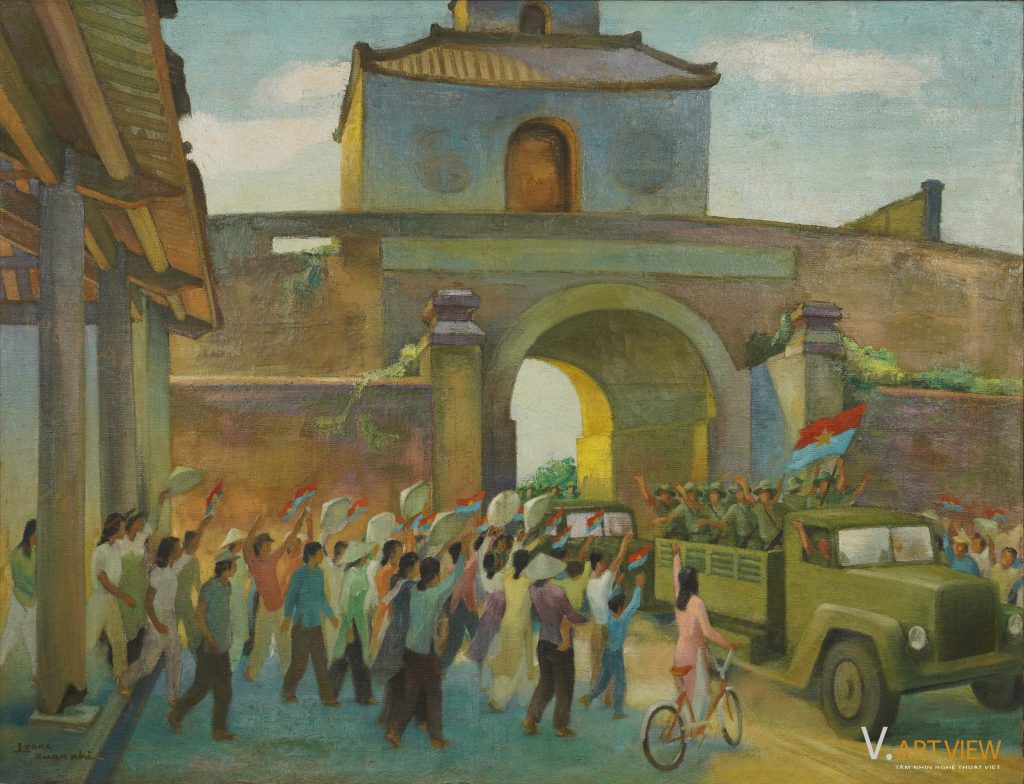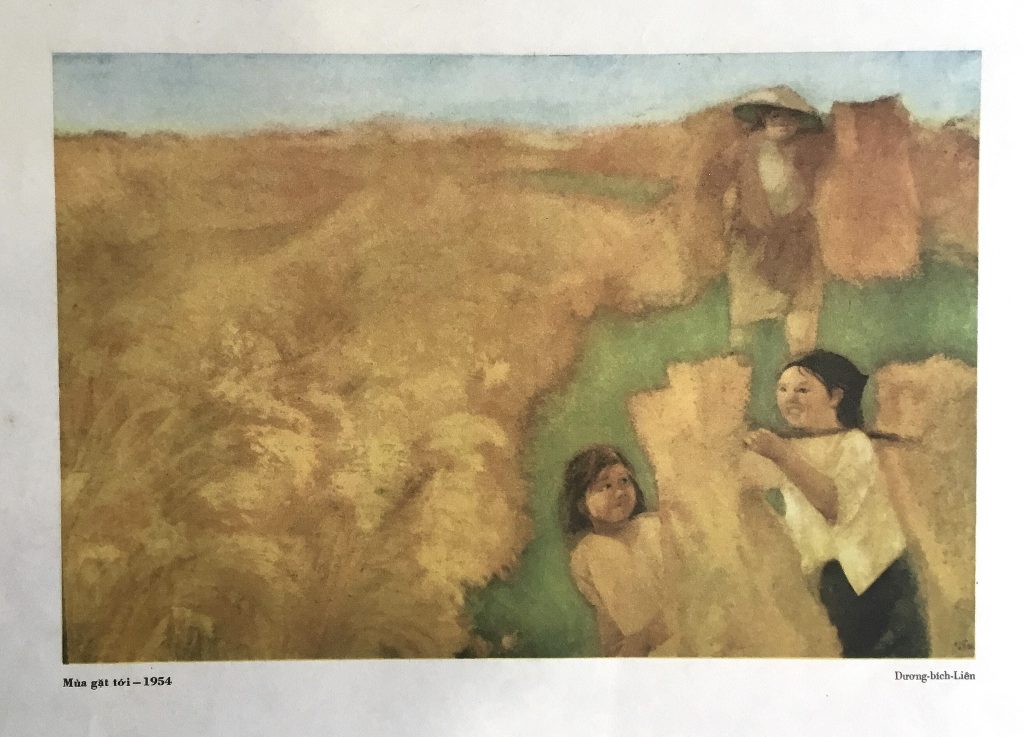ARTIST: LƯƠNG XUÂN NHỊ (1914-2006)
The name of the painting that given by the artist: “… the liberation army”
The name given by collector Nguyễn Mạnh Phúc: “Huế – The paean of victory”
Date: 1984. Medium: Oil. Dimensions: 100×130 cm
Romantic Realism and Revolutionary Realism
When we talk about artist Lương Xuân Nhị, art lovers will surely remember the beautiful, modest, graceful young women of old Hà Nội in áo dài surrounded by peaches, lotus, chrysanthemums, and willow branches or poetic landscape, full of clear blue and yellow. Basically, it is information that appears a lot in documents. But in fact, Lương Xuân Nhị painted with a lot of subjects. He is an artist of paintings with historical themes, revolutionary war, labor and production. In the years before 1945, he created paintings with themes of social life such as “Fishing boat family”, “Drink shop”; life scenes in the countryside, mountains… Not only that, he was also the artist of enemy propaganda leaflets during the resistance war against the French colonialists. With every subject, he left a bold personal mark.
From the landscape of old Huế capital…
The old capital of Huế in the minds of Vietnamese people is filled with lavish and magnificent palaces and mausoleums. For artists, Huế is like an endless theme of landscape, architecture, people… portrayed richly and nuanced in literature, poetry, music, and painting. Lương Xuân Nhị is a person who loves Huế. His compositions of Huế in every period, medium and subject are beautiful, poetic, carrying moods. In 1938, he created the work “House of Thủy Tạ – Mausoleum of Tự Đức” (oil painting) with a light gray color, carrying a sadness in the mind of a Vietnamese person when facing the historical relics of a dynasty that has passed. In 1978, he created “Boat on Hương river” in a different mood. It is still poetic Huế with the image of Hương river and boats; But the scenery is brilliant, filled with golden sunlight and trees on both sides of the river.
… To “Huế – The paean of victory”
About 5 or 7 years ago, Viet Art View saw an oil painting by artist Lương Xuân Nhị at the residence of collector Nguyễn Mạnh Phúc. The painting depicts people from different classes, joyfully waving flags and flowers to welcome liberation soldiers sitting on vehicles moving through a very large city gate.

ARTIST: LƯƠNG XUÂN NHỊ (1914-2006)
The name of the painting that given by the artist: “… the liberation army”
The name given by collector Nguyễn Mạnh Phúc: “Huế – The paean of victory”
Date: 1984. Medium: Oil. Dimensions: 100×130 cm
“I know this painting is that after the 1985 national exhibition, this painting went to Mr. Lưu Nguyên at Trần Quốc Toản. Mr. Lưu Nguyên is a very close friend of Lương Xuân Nhị and Mr. Lưu Nguyên and I are also forget-about-age friends who collecting antiques. After the National Exhibition in 1985, he (painter Lương Xuân Nhị) ceded it to Mr. Lưu Nguyên and by chance, one time when I came to visit, I met both the artist and the owner, we talked about this painting.”
True to collector Nguyễn Mạnh Phúc’s story, the back of the painting still has the delivery note from the “National Fine Arts Exhibition” in 1985. But after nearly 40 years, the ink has faded so the part that written the name of work is faint with the words “đoàn quân” [the army], dimensions 130×100 cm, date 1984.

At the back of the painting
Based on characters and architectural landscapes, this painting was created by artist Lương Xuân Nhị on the basis of two works about a Huế city gate (the book “Lương Xuân Nhị” page 116). This is one of eighteen city gates leading into the inner city of Huế. Although there are no captions, only the architectural identification shows that the painting depicts (on the inside of the citadel) Đông Ba gate, one of the main entrances of the Huế citadel. Some documents state that the “Thượng Tứ” and “Đông Ba” gates were two of the main entrances for the liberation army to liberate Huế in 1975.
“In Huế, he previously had a painting “ The old Huế imperial city”, after participating in the national exhibition in 1985, he relied on documents of the old Huế imperial city and he began to paint more Huế people welcoming the southern liberation army coming to liberate Huế, this is the theme of war. And often, people don’t like the topic of war because it has a war theme, but for me, I really like this topic because it belongs to a historical topic. If we talk about Việt Nam and America, then Việt Nam is a resilient country that has resisted the two largest empires in the world, the French colonialists and the American imperialists. It goes deep into Việt Nam’s history of building and defending the country. So people don’t understand because a painting has its own destiny, it has its own life, it is just like humans, so here this war topic is very attractive because it is after the war. The old Huế imperial city welcomed the southern liberation army to liberate it, creating a jubilant atmosphere for Vietnamese people when they defeated the American imperialists.”
Collector Mạnh Phúc shared that he loves the painting, he usually call it “Huế – The paean of victory”.
“I see it is “The paean of victory” because I think of Arc de Triomphe of Paris. Well, the reason of the name is like that, so a painting it has its own life, it has its own destiny, so it depends on the collector to discover the painting.”
The work of art is the brainchild of the artist. Therefore, the title of artwork often implies the content of the work. But there are collectors who, after owning the copyright of the work, discover for themselves another calling from their own personal feelings. That is also their love for the work, giving it a different name in parallel with the respect for the artwork.
“I really appreciate and keep this painting even though people don’t like the theme of war, but from a collection perspective, we have to understand that it still has artistic value, historical value, then why don’t we keep it? So I really favourite it and I hang it in a front area of this room, which shows how much I appreciate it. the artist’s responsibility to record an lifelong image for the country, he followed his own path, which was very lyrical and gentle, after the war, not during the midst of fire. This is a topic that I think is suitable for not only Lương Xuân Nhị but also artists who are responsible for the country. This is a very beautiful ending that is also appropriate to Lương Xuân Nhị’s mood and mentality.”

With a revolutionary themed painting, reading the content of the work is also understanding the artist’s thoughts and feelings; helps viewers put themselves in the artist’s position. Why did a calm, well-balanced and deliberate person like Lương Xuân Nhị became joyful, excited, and bustling with “Huế – The paean of history”, a historical political subject that requires processing a lot of data, historical events, from architecture to artifacts, people, cover a vast landscape with details showing… We could only explain it from a great love for the homeland; silent gratitude to the people who made the glorious victory possible, from the artist’s very soul.
Written by Viet Art View
Copyrights belong to Viet Art View








